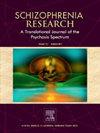Comorbidity of anorexia nervosa and schizophrenia: A systematic review
IF 3.6
2区 医学
Q1 PSYCHIATRY
引用次数: 0
Abstract
Research on the intersection between eating disorders and schizophrenia (SCZ) has mainly focused on binge eating, since increased appetite and metabolic side effects are common during antipsychotic use. However, the prevalence of restrictive eating and anorexia nervosa may be higher in people with SCZ than in the general population, and evidence suggests shared genetic liability for SCZ and anorexia nervosa (AN). The aim of this systematic review was to examine the prevalence, psychological and biological mechanisms, and theoretical underpinnings underlying the co-occurrence of AN and SCZ. We identified 40 articles that met inclusion criteria. Evidence suggested that the prevalence of AN in patients with SCZ is higher than would be expected in the general population; conversely, evidence regarding the prevalence of SCZ in AN was mixed. Psychological mechanisms underlying AN in people with SCZ fell into three categories: positive symptoms, negative symptoms, and atypical pathways. A limited literature generally supports the hypothesis of higher prevalence of AN in patients with SCZ, but there are few studies in this area. Studies of the prevalence of SCZ in AN yield more mixed findings, although these studies are also relatively small and few. Further, studies of both types tend to include only clinically ascertained samples, which limits the generalizability of findings beyond patients. Larger, better-designed studies may improve identification and treatment of people with co-occurring SCZ and AN.
求助全文
约1分钟内获得全文
求助全文
来源期刊

Schizophrenia Research
医学-精神病学
CiteScore
7.50
自引率
8.90%
发文量
429
审稿时长
10.2 weeks
期刊介绍:
As official journal of the Schizophrenia International Research Society (SIRS) Schizophrenia Research is THE journal of choice for international researchers and clinicians to share their work with the global schizophrenia research community. More than 6000 institutes have online or print (or both) access to this journal - the largest specialist journal in the field, with the largest readership!
Schizophrenia Research''s time to first decision is as fast as 6 weeks and its publishing speed is as fast as 4 weeks until online publication (corrected proof/Article in Press) after acceptance and 14 weeks from acceptance until publication in a printed issue.
The journal publishes novel papers that really contribute to understanding the biology and treatment of schizophrenic disorders; Schizophrenia Research brings together biological, clinical and psychological research in order to stimulate the synthesis of findings from all disciplines involved in improving patient outcomes in schizophrenia.
 求助内容:
求助内容: 应助结果提醒方式:
应助结果提醒方式:


